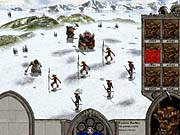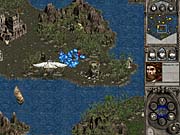Disciples II: Dark Prophecy Designer Diary #7
Strategy First artist Alexandre Rodrigue describes his duties on Disciples II.
Entry #7 - 06/05/01
By Alexandre Rodrigue
Artist, Strategy First

I'd like to start this designer diary by telling you about myself. My name is Alexandre Rodrigue, and I've been working on Disciples II for the past five months. I've kept busy during this time by working for the most part on the buildings found on the isometric (strategic) map and by working on the new battle backgrounds. This includes concept art as well as in-game material. Basically, my job is to make the world of Disciples II come to life. Before I started working on Disciples II, I sat with Patrick Lambert (lead artist), and we reviewed the work that had to been done and discussed where we wanted to take it. We worked on new concepts and focused on creating a unique ambiance for the Disciples universe.

Without a doubt, we both agreed that this world wasn't dark enough, since Nevendaar was a world that was trapped in the turmoil of war, and we wanted to reflect this by showing each race at its darkest hours. Since the modeling for the units was complete, I based my work around what was already completed--for example, the volcanic ash look of the Legions of the Damned. In general, we wanted to distance ourselves from the cartoon look of Disciples: Sacred Lands, but the problem was that about a year's worth of art had already been worked on, which made the decision to change the overall look of the game even more difficult. But that decision was made as soon as we saw the first version of the game with the new concept art. There was no way we were going to keep the older artwork in the game. If there is a problem with this, it's that almost all of the screenshots of Disciples II don't really show the new work. Even though the change of direction has been underway for a few months, most of the screenshots don't reflect all that is new in the game. Even the ones that will appear with this designer diary are not really reflective of the revised art direction. So, people will be amazed when they see the final game. We had to keep people guessing...
In my opinion, the creation of in-game art is the most interesting part of my job, and to inspire myself, I try to surround myself with items that relate to my work--often, fast sketches that I draw myself. For example, for the Legions of the Damned, there is nothing more inspirational than listening to Celine Dion with the speakers set to full blast. For the Undead Hordes, it's a midnight stroll through my favorite cemetery. What I really enjoy is that I don't have to hold back in my creative process, and I'm not sure if I would have this same opportunity working on another project. This is the first time I've worked on a 2D turn-based game, and I don't miss the technical limitations that come with working on a 3D real-time game. Even though the industry tends to shine more light on the higher-octane real-time games, I'm enjoying the fact that I don't have to limit my creativity because of the limitations of the game engine.
Isometric Map Challenges
One of my biggest challenges in the game comes from trying to make the buildings and structures of the isometric map fit with the terrain. Terrain is an important factor in the Disciples world, and each race has a distinctive terrain type that reflects its influence on the world. Since every building can appear on each of the five different terrain types as the buildings are designed, I have to consider that they have to look good on each and every one of them.

Isometric Lighting
Every structure in the game has to have the same light source. So the first thing we do is set the palette, the light source, and direction for every object. A problem that often arises is in setting the scale for an object, because it can have an impact on the lighting, and what is true in the real world can't always be respected because it doesn't always give the best results. So even though there are settings that are standard for all the objects, oftentimes you still have to go back and retouch each and every object one at a time to make sure you get the proper result.

Textures
Unlike real-time engines, our models are prerendered with the textures. In a real-time engine, each object has one texture for the entire object, and for a building, this texture has to represent the windows, walls, grass, and whatever else makes up a building. Since everything is prerendered, I can use as many textures as I like, because I don't have the limitation problems that go along with real-time engines. After a structure has been modeled, textured, and rendered, I usually touch up each image in Photoshop, and from there, it's on to the in-house integration tools that help the finished product make its way into the game. And this is done for each and every object in the game!
So since I've joined the Disciples II team, I've seen the transformation of this game, and in the next few weeks, I'm sure you'll see the newer screenshots, which I hope will make Disciples II live up to your expectations.
Got a news tip or want to contact us directly? Email news@gamespot.com
Join the conversation